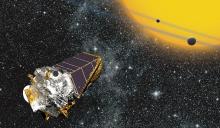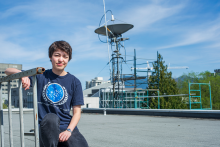Two Canadian amateur stargazers get to trade in their backyard telescopes for one 820 kilometres up in space.
Dozens of proposals poured in over the last year after scientists in charge of MOST—a Canadian Space Agency space mission headed by Physics and Astronomy professor Jaymie Matthews—asked Canadian amateur astronomers what they would do if they had access to the orbiting telescope.
"It's like a cosmic version of the Olympics," says Matthews.
David Gamey of Toronto and Gordon Sarty of Saskatoon have been chosen to tune into the vibrations of their favorite stars using the 'little space telescope that could.'
"Ordinary Canadians have proven themselves to be gold medalists reaching a podium which rises to the stars," says Matthews. "The many excellent proposals we received are worthy of our own Olympic slogan 'One Universe, Many Dreams.'" Gamey, an amateur astronomer who teaches Cubs and Scouts, chose Betelgeuse as his MOST target. One of the brightest stars in Canada's winter night sky, the red supergiant is in the shoulder of the constellation Orion the Hunter and about 800 times bigger than the Sun.
"Kids are fascinated by this bright star, asking me questions like: When will it explode? Will our Sun turn into a supergiant like Betelgeuse?" says Gamey. "They are like my collaborators on this proposal because Betelgeuse means so much to them. MOST will be the perfect bridge between these curious youngsters and some of the world's top scientists."
Sarty, a member of the Saskatoon Centre of the Royal Astronomical Society of Canada (RASC), chose a microquasar named LS 5039 as his target. A microquasar is a miniature version of the black holes at the cores of distant galaxies. In LS 5039, a star is locked in an orbit with a black hole, into which gas is plummeting and emitting "death cries" in the form of gamma rays.
"My five-year-old daughter Darien gave me a hug when I told her the news that I'd been selected," says Sarty, an expert on brain activity and MRI at the University of Saskatoon.
"I've been observing variable stars for almost 20 years using a homemade telescope and my eyeball," says Sarty. "It feels like a step up - way up - to observe a microquasar with Canada's space telescope."
The door remains open for other skygazers to submit ideas for the MOST space telescope.
Musqueam First Nation land acknowledegement
We honour xwməθkwəy̓ əm (Musqueam) on whose ancestral, unceded territory UBC Vancouver is situated. UBC Science is committed to building meaningful relationships with Indigenous peoples so we can advance Reconciliation and ensure traditional ways of knowing enrich our teaching and research.
Learn more: Musqueam First Nation
Faculty of Science
Office of the Dean, Earth Sciences Building2178–2207 Main Mall
Vancouver, BC Canada
V6T 1Z4


